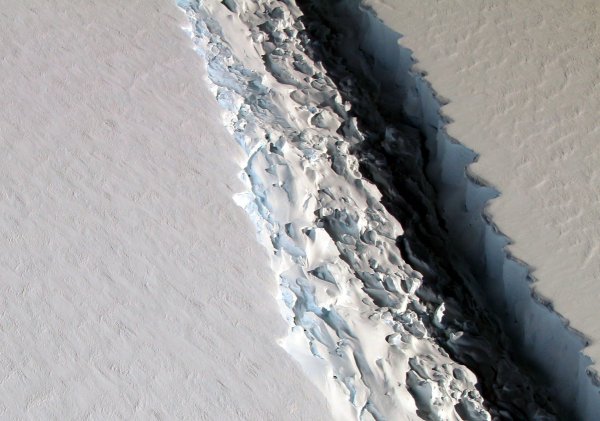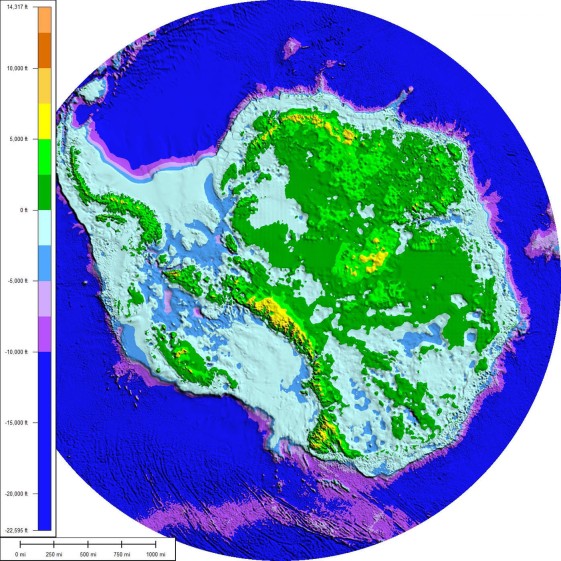One By One, the Flood Gates of Antarctica are Breaking Open
“This
kind of rifting behavior provides another mechanism for rapid retreat
of these glaciers, adding to the probability that we may see
significant collapse of West Antarctica in our lifetimes.”
“Burning
all the world’s coal, oil and gas would melt the entire Antarctic
ice-sheet and cause the oceans to rise by over 50m, a transformation
unprecedented in human history. The conclusion of a
new scientific study shows
that, over the course of centuries, land currently inhabited by a
billion people would be lost below water.”
*****
****
6
December, 2016
Massive
Rift Forming in Larsen C
Larsen
C.
It’s the next big ice shelf on the butcher’s block in West
Antarctica. And now it appears the shelf may be well on its way to
facing the same fate as its companions Larsen A and Larsen B. That
fate — disintegration and the ultimate release of glaciers that
have been held in check for thousands of years into the world ocean.
It
was only about 150 years ago that the Larsen Ice shelves were
discovered. And the Larsen shelf system is thought to have been
mostly stable throughout the last 12,000 years. But in 1995 Larsen A
splintered into a million icebergs. And in 2002 the larger portion of
Larsen B broke apart. Warming Ocean waters heated by an atmosphere
loaded with greenhouse gasses did the damage. And now the same warm
water currents that shattered Larsen A and Larsen B are endangering
their larger cousin — Larsen C.

(Ice
shelves and sea fronting glaciers serve as the flood gates keeping
West Antarctica’s glaciers from spilling into the ocean and raising
sea levels by as much as 20 feet. But warm ocean waters are causing
these flood gates to melt and crack wide open. The above image shows
a massive abyssal rift forming in the Larsen C ice shelf. A similar
rift formed in the center of the Pine Island Glacier last year. A
signal that the West Antarctic Ice Sheet could undergo a major
collapse over the next 100 years. Image source: NASA.)
For
today, a huge rift running through the ice shelf is
about to break off a Delaware-sized iceberg into the Atlantic Ocean.
The rift is broadening, deepening and extending. And
it now measures 70 miles long, 300 feet wide, and a third of a mile
deep.
Once this enormous abyssal crack runs its course and causes about 10
percent of the ice shelf to break off, the big land-grounded glaciers
sitting upon mountainous slopes behind the ice shelf will have less
protection. They will increase their forward speed and contribute
larger volumes of ice outflow to the growing problem of global sea
level rise.
In
this way, rifts in Antarctica’s sea fronting glaciers and ice
shelves can be seen as giant cracks in the flood gates holding back
enormous glaciers that, when released, will lift global sea levels by
feet and meters.
Big
Crack in the Pine Island Glacier
Closer
to the center mass of West Antarctica, the Pine Island Glacier serves
as one of the most important of these flood gates. In total, the
large grounded glaciers in what could best be termed as an ice bottle
neck hold back about 10 percent of all of West Antarctica’s
interior ice mass. But just last year a huge rift that formed in this
glacial buttress during 2013 cracked wide open — causing three
massive icebergs totalling ten times the size of Manhattan to break
off.
According
to a new study,
warm ocean water flooded far inland along the underside of the Pine
Island Glacier. It ate away at its base and then spilled down-slope
to cut out a melting hollow in the glacier’s heart. Ultimately, an
enormous crack formed within the glacier 20 miles away from where the
ice mass meets the ocean at the surface.
Massive crack forms in the Pine Island Glacier, then causes three very large icebergs to break off during 2015. A new study finds that the Pine Island Glacier is melting from the inside out and an inland flood of warm ocean water is causing both the melt and the formation of large rifts in the ice. Scientists believe that these could be the first signs of a significant collapse of West Antarctica that could occur without our lifetimes. Video source:Ohio State.)
Then,
in 2015, gigantic
chunks of ice covering 225 square miles broke off from the Glacier
and floated out into the Amundsen Sea.
This was the second series of icebergs to break off from the Pine
Island Glacier in as many years.
And scientists were notably very concerned.
Pine
Island Glacier is particularly vulnerable because it sits on a
reverse slope. In other words, a below sea level bed slopes lower as
you progress toward the center of the Continent. And, in fact, large
portions of West Antarctica are below sea level (see topographic
image below).
Pine
Island Glacier itself rests upon an opening to one of the deepest
valleys sloping inland. At the location of the Pine Island glacier a
rift between 500 and 2,000 feet below sea level runs down toward a
central region of West Antarctica that sits between 2,000 and 6,000
feet below sea level.
And within this basin is a pile of glacial ice that
from bedrock to its highest point above sea level towers two and a
half miles high.
The very valid concern for this glacier is that melt and rifting,
once started, will tend to accelerate — taking out larger and
larger chunks of the inland ice as it is exposed to the warming ocean
and heating atmosphere.
The
Larger Picture — Glacial Flood Gates are Cracking Open
Larsen
C and Pine Island Glacier serve as but two of the many flood gates
that run all along the coast of West Antarctica and East Antarctica.
But the increasing flows of warm water coming in from the ocean and a
related rise in the frequency of events where large masses of ice
break off from buttressing glaciers and ice shelves has put West
Antarctica in danger of facing a near term collapse.

(Islands
encased in ice. Much West Antarctica, on the left side of this
topographic image, sits between 0 to 6,000 feet below sea level. If
the buttressing glaciers and ice shelves like Larsen C and Pine
Island are lost, there is little to prevent the warming oceans from
flooding inland and setting off a rapid cascade of melt and seaward
outflow. Scientists now believe that such a collapse could happen
within our lifetimes. Image source: Antarctic
Bedrock.)
With
information from new glacial stability assessments in hand, Antarctic
ice specialists are warning that the western region of this frozen
land may collapse in a major melt event that
over the next 100 years could raise sea levels by 10 feet.
And West Antarctica is but one of three global regions — including
Greenland and East Antarctica — capable of contributing significant
glacial outbursts during this period.
Links:
Hat
tip to Colorado Bob
Hat
tip to ClimateHawk



No comments:
Post a Comment
Note: only a member of this blog may post a comment.